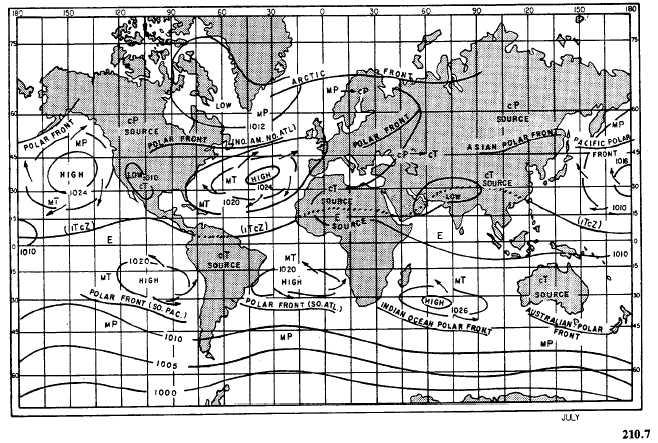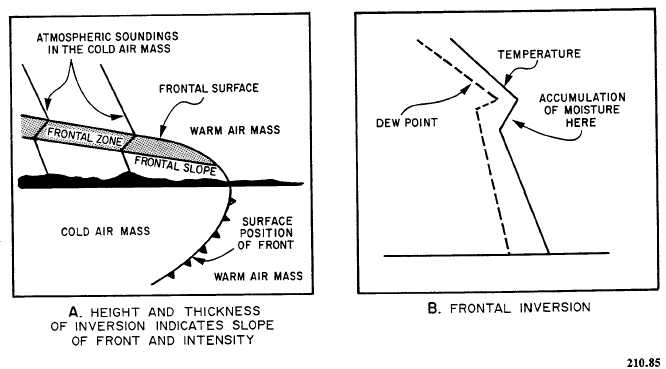|
| |
[ Back ] [ Home ] [ Up ] [ Next ]
Click
here to Order your Radar Equipment Online
FRONTAL
ELEMENTS From our
previous discussion and definitions of
fronts, it was implied that a certain geometrical and
meteorological consistency must exist between fronts
at adjoining levels. It can also be inferred that
the data at no one particular level is sufficient to
locate a front with certainty in every case. We must
consider the horizontal and vertical distribu-tion of
three weather elements (temperature, wind, and
pressure) in a frontal zone.
Temperature
Typical fronts always consist of warm air above
cold air. A radiosonde observation taken through
a frontal surface often indicates a relatively
narrow layer where the normal decrease of
temperature with height is reversed. This temperature
inversion is called a within
the inversion layer and the thickness of the layer
can be used as a rough indication of the intensity
of a front. Strong fronts tend to have a
distinct inversion; moderate fronts have isother-mal frontal
zones; and weak fronts have a decrease
in temperature through the frontal zone. Frontal
zones are often difficult to locate on a
sounding because air masses become modified after
leaving their source region and because of turbulent
mixing and falling precipitation through the
frontal zone. Normally, however, some indica-tion does
exist. The degree to which a frontal zone appears
pronounced is proportional to the temperature
difference between two air masses. The
primary indication of a frontal zone on a
Skew T diagram is a decrease in the lapse rate somewhere
in the sounding below 400 mb. The decrease
in lapse rate maybe a slightly less steep lapse
rate for a stratum in a weak frontal zone to
a very sharp inversion in strong fronts. In addition
to a decrease in the lapse rate, there is
usually an increase in moisture (a concurrent dew-point
inversion) at the frontal zone. This is especially
true when the front is strong and abundant
cloudiness and precipitation accompany it.
View A of figure 4-2-8 shows the height of the

Figure
4-2-7.Chart showing world air masses, fronts, and centers of major pressure
systems in July.

Figure
4-2-8.Inversions.
inversion in two different parts of a frontal zone, and
view B of figure 4-2-8 shows a strong frontal inversion
with a consequent dew-point inversion. A
cold front generally shows a stronger inver-sion than
a warm front, and the inversion appears at
successively higher levels as the front moves past
a station. The reverse is true of warm fronts. Occluded
fronts generally show a double inver-sion. However,
as the occlusion process continues, mixing
of the air masses takes place, and the inversions
are wiped out or fuse into one inver-sion. It
is very important in raob analysis not to con-fuse the
subsidence inversion of polar and arctic air
masses with frontal inversions. Extremely cold continental
arctic air, for instance, has a strong inversion
that extends to the 700-mb level. Sometimes
it is difficult to find an inversion on
a particular sounding, though it is known that a
front intersects the column of air over a given station.
This may be because of adiabatic warm-ing of
the descending cold air just under the fron-tal surface
or excessive local vertical mixing in the vicinity
of the frontal zone. Under conditions of subsidence
of the cold air beneath the frontal sur-face, the
subsidence inversion within the cold air may
be more marked than the frontal zone itself. Sometimes
fronts on a raob sounding, which might
show a strong inversion, often are accom-panied by
little weather activity. This is because of
subsidence in the warm air, which strengthens the
inversion. The weather activity at a front in-creases only
when there is a net upward vertical motion
of the warm air mass.
[ Back ] [ Home ] [ Up ] [ Next ]
|
